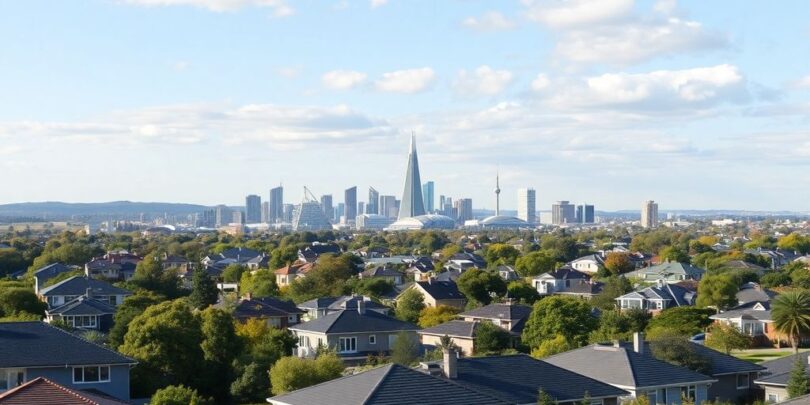As we approach 2025, understanding the trends and predictions surrounding house prices in Canberra is more important than ever. The local market has shown signs of stagnation, yet various analysts have differing views on what the future holds. With factors like interest rates and regional variations influencing prices, it’s crucial for buyers and investors to stay informed. This article will explore current trends, future forecasts, and the dynamics shaping the housing market in the nation’s capital.
Key Takeaways
- Canberra’s median house price is currently around $852,000, reflecting a 6.5% drop from its peak in March 2022.
- Forecasts for 2025 vary widely, with predictions of a price drop of 2-6% from some analysts, while others expect a 6% increase.
- Interest rates and economic conditions are key factors affecting house prices in Canberra.
- Certain suburbs, like Dunlop and Tuggeranong, are showing resilience and potential for growth despite current market challenges.
- Affordability remains a significant issue, with many buyers struggling to enter the market due to rising costs.
Current Trends In House Prices Canberra
Annual Price Changes
Okay, so let’s talk Canberra property. It’s been a bit of a mixed bag lately. We saw a tiny rise of 0.2% in dwelling values in March, but overall, things are pretty flat. Over the last year, dwelling values actually went down by about 0.5%. It’s not a huge drop, but it’s definitely something to keep an eye on. The median dwelling value is sitting around $854,398. Not exactly cheap, is it?
Impact of Interest Rates
Interest rates are still playing a big role, no surprises there. With rates staying pretty high, people are being a bit more careful with their money. It’s making it harder for some to get a loan, and that’s definitely having an impact on how much people are willing to spend on a house. It’s a bit of a domino effect, really. High rates mean less borrowing, which means less demand, and that can put downward pressure on prices. Getting a free property report can help you understand how these factors affect your property’s value.
Regional Variations
It’s not all the same story across Canberra. Some areas are doing better than others. You’ve got your high-growth suburbs where prices are still climbing, and then you’ve got other areas where things are a bit more stagnant. It really depends on the suburb, what kind of houses are available, and what people are looking for. For example, areas with good schools and close to the city centre tend to hold their value better. It’s worth doing your homework and looking at the specific area you’re interested in. Dunlop, 2615, is one area that some analysts are watching closely for potential growth in 2025.
The Canberra property market is complex, and it’s important to stay informed about the latest trends. Keep an eye on interest rates, economic indicators, and local developments to get a better understanding of where the market is headed.
Forecasting The Future Of House Prices Canberra
Predicted Price Movements
Okay, so trying to figure out where Canberra house prices are headed is like trying to predict the weather – everyone’s got an opinion, and nobody really knows for sure! Some experts reckon we might see a bit of a dip, while others are saying prices will actually go up. It’s a bit of a mixed bag, really. The key thing is that forecasts vary quite a bit.
- Some predict a fall of around 2-6%.
- Others are more optimistic, suggesting growth of up to 6%.
- A lot hinges on interest rates and how people are feeling about the economy.
Factors Influencing Growth
There are a bunch of things that could push house prices up or down. Interest rates are a big one – if they stay high, it’ll be harder for people to borrow money and buy houses. The economy is another factor; if things are going well, people will be more confident about buying. And then there’s the whole supply and demand thing – if there aren’t enough houses to go around, prices will probably rise. Keep an eye on investment property trends to see how they might affect the market.
- Interest rate changes by the Reserve Bank.
- Consumer confidence and overall economic health.
- The level of new construction and housing supply.
It’s worth remembering that these are just predictions. The market can change quickly, and what looks likely today might not be the case tomorrow. So, do your homework and don’t rely solely on forecasts.
Expert Opinions
It’s always good to hear what the experts are saying, but remember they don’t always agree! Some analysts are pretty cautious, pointing to affordability issues and a potential oversupply of apartments. Others are more upbeat, highlighting Canberra’s strong economy and growing population. The best approach is to read a range of opinions and make up your own mind. Getting a free property report can also help you understand the local market better.
Here’s a quick look at what some of the big banks are predicting:
| Bank | Forecast |
|---|---|
| ANZ | 5-6% increase in capital city property prices |
| KPMG Australia | 6% growth in Canberra house prices |
Market Dynamics Affecting House Prices Canberra

Supply and Demand Factors
Okay, so what’s actually moving the market in Canberra? Well, it’s the classic supply and demand dance. We’ve seen a bit of a squeeze lately. Not enough houses to go around, especially the types people actually want. This pushes prices up, naturally. But it’s not just about the number of houses; it’s also about where they are and what they offer. A tiny apartment in the city isn’t the same as a four-bedroom house in the suburbs, right?
- Limited land availability constrains new developments.
- Population growth continues to outpace housing supply.
- Increased demand for larger homes post-pandemic.
Economic Influences
The overall health of the economy plays a massive role. When things are looking good, people feel more confident about buying. They’re more likely to take out a loan and invest in property. But when the economy is shaky, and job security is uncertain, people tend to hold back. Interest rates are a big one too. If rates are low, borrowing money is cheaper, which can fuel demand and push prices up. If rates are high, it can cool things down pretty quickly. The Canberra property market is sensitive to these shifts.
Economic stability is key. A strong job market, low unemployment, and rising wages create a positive environment for house price growth. Conversely, economic downturns can lead to price stagnation or even declines.
Government Policies
Government policies can really shake things up. Think about first home buyer grants, stamp duty concessions, or changes to zoning regulations. These things can all have a direct impact on demand and supply. For example, if the government introduces a generous grant for first-time buyers, you might see a surge in demand, especially at the lower end of the market. Or, if they change zoning laws to allow for more high-density development, that could increase the supply of apartments and potentially ease price pressures. It’s all connected. Here’s a quick look at some potential policy impacts:
| Policy | Potential Impact |
|---|---|
| First Home Buyer Grants | Increased demand, especially for entry-level homes |
| Stamp Duty Concessions | Reduced upfront costs, stimulating buyer activity |
| Zoning Regulation Changes | Increased housing supply, potentially lower prices |
Suburb-Specific Insights On House Prices Canberra
High-Growth Areas
Okay, so Canberra’s a bit of a mixed bag right now, right? Some suburbs are just cruising along, while others are absolutely booming. Places like Gungahlin have seen a fair bit of action, with new developments popping up all over the place. But it’s not just about new builds; established areas like Dickson, with their proximity to the city and good amenities, are also seeing prices creep up. It’s all about location, location, location, as they say. Keep an eye on suburbs with planned infrastructure upgrades, because that’s usually a good sign of future growth. Getting a free property report can really help you understand how a property stacks up in the local market.
Affordable Suburbs
Finding a place that doesn’t break the bank in Canberra can feel like searching for a unicorn, but they’re out there! Suburbs like Belconnen and Charnwood still offer relatively affordable options, especially if you’re willing to look at units or older homes. Banks is one of the most affordable suburbs in the ACT. The key is to be flexible and maybe compromise on size or location. Think about what’s really important to you – is it being close to the city, having a big backyard, or being near good schools? Once you know your priorities, it’s easier to narrow down your search and find a suburb that fits your budget.
Investment Opportunities
If you’re thinking about investing in Canberra property, there are a few things to keep in mind. Rental yields are a bit subdued compared to other capital cities, but there’s still potential for capital growth, especially in areas with strong demand. Consider suburbs with a high proportion of renters, as these can provide a steady income stream. Also, look at areas with planned developments or infrastructure upgrades, as these can boost property values over time. It’s all about doing your research and finding a property that ticks all the boxes. Here’s a few things to consider:
- Location: Proximity to amenities, transport, and employment hubs.
- Rental Yield: The annual rental income as a percentage of the property value.
- Capital Growth Potential: The likelihood of the property increasing in value over time.
Canberra’s property market can be tricky, but with the right knowledge and strategy, you can find a suburb that suits your needs and budget. Don’t be afraid to do your research, talk to local agents, and get a feel for the different areas before making a decision. And remember, it’s a marathon, not a sprint!
Comparative Analysis Of House Prices Canberra
Versus Other Capital Cities
Okay, so let’s have a yarn about how Canberra stacks up against other Aussie capitals, especially Sydney and Melbourne. Canberra’s always been a bit of a unique market, right? Smaller, more government-driven, and generally a bit more stable than the rollercoaster rides you see in Sydney or Melbourne. But how does that translate to actual numbers?
Sydney’s housing market is projected to see home prices rise by 4-6% for houses and 3-5% for units in 2025, with the median house price potentially reaching $1.75 million. While interest rate cuts may stimulate buyer activity, affordability challenges persist, pushing buyers towards townhouses or apartments. Compared to Melbourne, which is experiencing stronger growth, Sydney’s home values have increased modestly by 0.9% annually. The demand for houses is outpacing that for units, indicating a robust market for family homes.
Canberra’s median dwelling price is around $854,398. That’s a fair bit lower than Sydney, but still pretty hefty compared to some other capitals. The thing is, Canberra hasn’t seen the same crazy booms and busts as Sydney. It’s been more of a steady climb, which can be good or bad depending on what you’re after. If you’re looking for quick gains, maybe Canberra isn’t your best bet. But if you want something a bit more reliable, it could be a solid choice.
Historical Price Trends
Let’s take a quick trip down memory lane, shall we? Looking back at Canberra’s house prices over the last decade, you see a pretty clear upward trend, but with some interesting bumps along the way. We had that big surge during the pandemic, like everywhere else, but Canberra’s market seems to have cooled off a bit more since then.
- Pre-Pandemic (2015-2020): Steady growth, nothing too wild. Canberra was doing its thing, quietly chugging along.
- Pandemic Boom (2020-2022): Prices went bonkers, driven by low interest rates and everyone suddenly wanting more space. Remember those days?
- Post-Boom (2022-Present): A bit of a correction, with prices stabilising or even dipping slightly. The market’s catching its breath.
It’s important to remember that past performance isn’t a guarantee of future results. But understanding these historical trends can give you a better idea of what to expect.
Long-Term Growth Potential
So, what’s the long game for Canberra house prices? Well, that’s the million-dollar question, isn’t it? There are a few things to consider. Canberra’s got a pretty stable economy, thanks to all the government jobs. That means there’s usually a steady demand for housing. Plus, Canberra’s a pretty desirable place to live, with good schools, lots of green space, and a generally relaxed vibe. But, like anywhere, there are challenges. Affordability is a big one, and rising interest rates could put a damper on things. Overall, most experts seem to think Canberra will continue to see steady, if not spectacular, growth in the long term. It might not be the place to get rich quick, but it could be a solid investment for the future. Keep an eye on those Canberra property market trends though, things can change quickly!
Challenges Facing House Prices Canberra

Affordability Issues
Let’s be real, getting into the Canberra property market is tough. House prices are high relative to incomes, making it a real struggle for first-home buyers and even those looking to upgrade. It’s not just about the initial purchase price either; stamp duty, legal fees, and other costs add up quickly. This creates a significant barrier for many people wanting to own a home in the ACT.
Investor Sentiment
Investor sentiment can be a fickle thing, and it definitely impacts Canberra’s house prices. Changes in interest rates, economic forecasts, and even what’s happening in other property markets can influence whether investors are keen to buy or more inclined to sell. If investors get spooked, it can lead to a drop in demand and, consequently, a dip in prices. Keeping an eye on property market update is crucial for understanding these shifts.
Market Stagnation
Canberra’s property market has seen some pretty wild swings over the past few years, and there’s a risk of things just…stalling. We saw a modest monthly rise of 0.2% in March 2025, but a negative quarterly trend of -0.1%. If prices don’t grow (or even decline), it can create uncertainty and make people hesitant to buy or sell. Nobody wants to buy a house that’s going to be worth less next year, right? This stagnation can be influenced by a bunch of factors, including:
- High interest rates making mortgages less affordable.
- A lack of new developments to meet demand.
- Economic uncertainty leading to cautious spending.
It’s a bit of a balancing act. We need enough growth to keep the market healthy, but not so much that it becomes unaffordable for the average person. Finding that sweet spot is the big challenge.
Strategies For Navigating House Prices Canberra
Buying Tips
Okay, so you’re thinking about buying in Canberra? It’s a bit of a mixed bag right now. Some experts are saying prices will drop, others are predicting growth. The key is to do your homework and not rush into anything.
Here’s a few things I’d keep in mind:
- Get your finances sorted: Know exactly how much you can borrow and what your repayments will be. Don’t just rely on what the bank tells you; factor in potential interest rate rises. It’s always good to check your borrowing power before you start seriously looking.
- Research, research, research: Don’t just look at the pretty houses. Check out the suburb, the schools (even if you don’t have kids, it affects prices), the transport links, and any planned developments.
- Be prepared to compromise: Unless you’ve got unlimited funds, you’ll probably have to make some compromises. Maybe it’s the size of the backyard, the age of the kitchen, or the distance to the shops. Figure out what’s most important to you and focus on that.
It’s a good idea to get a building and pest inspection done before you make an offer. It might cost a few hundred dollars, but it could save you thousands in the long run if it uncovers any hidden problems.
Investment Strategies
Investing in Canberra property can be a smart move, but it’s not a guaranteed win. You need to think long-term and be prepared for ups and downs. Here’s a few ideas:
- Consider different property types: Houses are generally seen as a safer bet, but units can offer better rental yields. Think about your risk tolerance and investment goals.
- Look for areas with growth potential: Some suburbs are tipped to outperform others. Do your research and look for areas with good infrastructure, strong employment prospects, and increasing demand.
- Think about rental income: If you’re planning to rent out your property, factor in the potential rental income and vacancy rates. Talk to a local property manager to get an idea of what you can expect.
Market Timing
Trying to time the market is always risky, but there are a few things you can look out for. Keep an eye on interest rates, economic growth, and supply and demand.
Here’s a quick look at some recent data:
| Statistic | Value |
|---|---|
| Median House Price (2024) | $852,000 |
| Annual House Price Growth | 0.7% |
| Annual Unit Price Growth | -2.9% |
Remember, past performance is not always indicative of future results. The Canberra property market can be unpredictable, so it’s important to stay informed and make decisions based on your own individual circumstances. Keep an eye on the Canberra property market trends to stay informed.
Final Thoughts on Canberra’s Housing Market
As we wrap up our look at Canberra’s housing scene, it’s clear there’s a lot going on. Prices have been a bit all over the place, with some forecasts suggesting a drop while others hint at growth. For anyone thinking about buying or selling, it’s a mixed bag. The market’s still feeling the effects of high interest rates and affordability issues, which makes things tricky. But there are pockets in Canberra that might just surprise you. Keeping an eye on local trends and being ready to act could be key in 2025. So, whether you’re a buyer, seller, or just curious, staying informed will help you navigate this unpredictable market.
Frequently Asked Questions
What are the current trends in house prices in Canberra?
Right now, house prices in Canberra are not changing much. They went up by just 0.7% this year, while unit prices dropped by 2.9%. The average price for a home is about $852,000, which is lower than what it was in March 2022.
How are interest rates affecting house prices in Canberra?
Interest rates play a big role in house prices. When rates go up, it can make it harder for people to borrow money. This means fewer buyers in the market, which can lead to lower prices.
What is expected for house prices in Canberra in 2025?
Experts have different views on what will happen in 2025. Some think prices might drop by 2% to 6%, while others believe they could rise by about 6%.
Which suburbs in Canberra are expected to grow the most?
Suburbs like Dunlop and Macarthur are expected to see good growth. These areas are still affordable and have shown strong price increases.
What challenges are house prices in Canberra facing?
One of the biggest challenges is affordability. Many people find it hard to buy homes because prices are high compared to their incomes. Also, the market is a bit slow, which makes it harder for sellers.
What tips are there for buying a house in Canberra?
If you’re looking to buy, it’s important to do your research. Look for areas that are expected to grow, and consider your budget carefully. Timing your purchase can also help you get a better deal.








